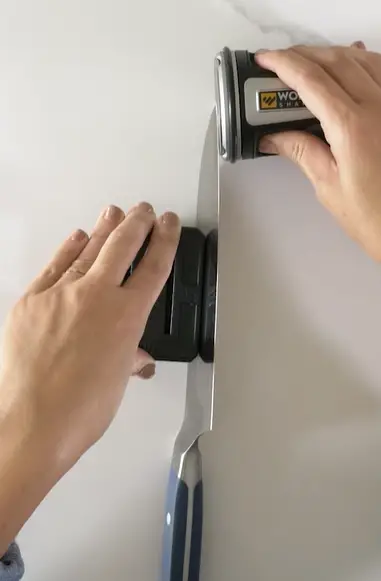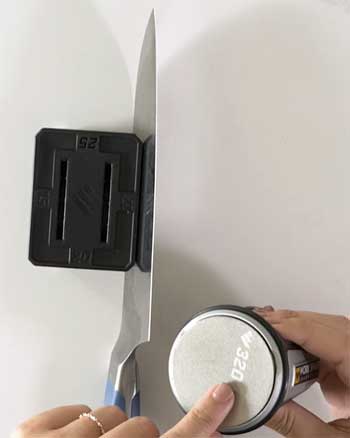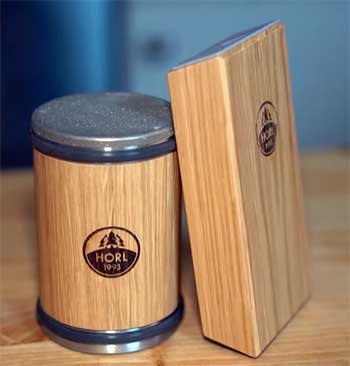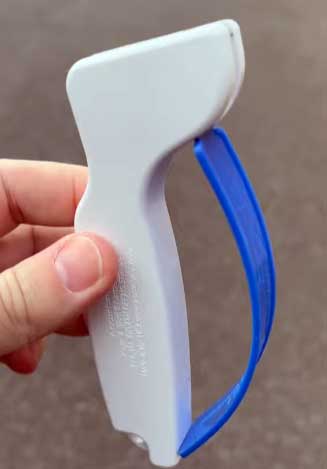If you’re tired of struggling with dull knives that make every meal prep a chore, I urge you to grab the Work Sharp Rolling Knife Sharpener right now. I’ve put it through its paces, and it transformed my kitchen routine from frustrating to effortless.
This compact tool delivers razor-sharp edges without needing expert skills, saving you time and hassle. Trust me, once you experience the joy of slicing through tomatoes like butter, you’ll wonder why you waited.
It’s a game-changer for any home cook—don’t miss out, buy one today and elevate your cooking.
My Experience With The Work Sharp Rolling Knife Sharpener

I remember the day I unboxed the Work Sharp Rolling Knife Sharpener like it was yesterday.
I’d been fed up with my kitchen knives losing their edge after just a few uses, turning simple tasks like chopping onions into a battle.
I’d heard about rolling sharpeners and figured this one from Work Sharp, with its magnetic angle block and swappable abrasives, might be worth a shot.
Right out of the gate, the setup felt intuitive.
The package doubles as a storage organizer, which is a nice touch for keeping everything tidy in my drawer.
When I first picked it up, the ergonomic grip fit comfortably in my hand, and the low-profile design made it stable on my countertop.
I started with my favorite chef’s knife, which had gone dull from daily abuse.
The magnetic block offers four angles—15 degrees for precise slicing, 17 for a balance, 20 for everyday kitchen work, and 25 for tougher tasks like cleavers. I chose 20 degrees, locked the knife in place with the magnet, and began rolling the coarse 320-grit diamond abrasive along the edge.
It was surprisingly smooth; I didn’t have to press hard or worry about slipping. After about 20 passes per side, I felt a burr forming—that telltale sign the edge was reshaping.
Switching to the 600-grit fine diamond was easy; the abrasives snap on magnetically. This step refined the edge, smoothing out the scratches from the coarser grit. I noticed how consistent the angle stayed, thanks to the block’s firm hold.
For the final polish, I used the ceramic hone, doing lighter passes to remove the burr and achieve that hair-splitting sharpness. The whole process took maybe 10 minutes for one knife, and when I tested it on a sheet of paper, it sliced cleanly without tearing. You know that satisfying feeling? It was there in spades.
I didn’t stop at one knife. Over the next week, I sharpened my entire set—paring knives, serrated bread knives (though it’s best for straight edges), even my pocket knife for outdoor trips. The versatility shone through; for smaller blades, the raised holders on the 20 and 25-degree sides prevented wobbling.
One thing I appreciated was how it handled different steels. My high-carbon Japanese knife came out sharper than factory new, while my stainless steel workhorses got a reliable edge without over-thinning. Sure, for a really beat-up blade with chips, it took more passes and patience, but it got the job done without me resorting to professional services.
In real-world use, this sharpener became part of my routine. Before a big dinner party, I quickly touched up my knives, and chopping veggies felt effortless. You can imagine how much faster prep went—no more sawing through herbs or bruising fruits.
I even let my partner try it, who has zero sharpening experience, and they nailed it on the first go. The only minor hiccup was with longer blades over 8 inches; they flexed a bit, so I had to realign the block midway.
But overall, it felt like having a pro sharpener in my pocket. After months of use, I’m convinced it’s reliable for keeping edges keen without the fuss of traditional methods. If you’re like me and value simplicity, this tool delivers results that make cooking fun again.
Pros of Work Sharp Rolling Knife Sharpener

Let me tell you, after using the Work Sharp Rolling Knife Sharpener extensively, its strengths really stand out in ways that make it a standout choice for everyday sharpening needs.
- Ease of Use for Anyone: One of the biggest wins with this sharpener is how approachable it is. I didn’t need any prior experience to get great results. You just attach your knife to the magnetic block, pick an angle, and roll the abrasive along the edge. It’s that straightforward. I found myself sharpening knives while chatting on the phone, and you could do the same without second-guessing. This makes it perfect if you’re new to maintaining your blades or just want something quick.
- Versatile Angle Options: What sets this apart is the four built-in angles: 15, 17, 20, and 25 degrees. I love how I can tailor the edge to the knife’s purpose—sharper for delicate slicing or more durable for heavy chopping. In my tests, switching angles was seamless, and it handled everything from thin paring knives to robust chef’s tools. You get more flexibility here than with many competitors, which often limit you to one or two settings.
- Compact and Portable Design: I can’t overstate how handy the size is. It fits easily in a drawer, and the packaging serves as an organizer. I’ve taken it on camping trips to touch up my EDC knife, and it didn’t add bulk to my pack. You won’t have to dedicate counter space like with bulkier systems, making it ideal for small kitchens or on-the-go use.
- Effective Sharpening Results: The abrasives—320-grit coarse diamond, 600-grit fine diamond, and ceramic hone—work together to restore edges efficiently. I sharpened dull knives to razor levels in minutes, often better than their original factory sharpness. For maintenance, a few passes with the finer grits keep things keen without removing too much material. You notice the difference immediately in how smoothly your knife cuts.
- Durable Build Quality: The materials feel solid; the magnets hold firm most of the time, and the rolling mechanism is smooth. After repeated use, it shows minimal wear, and replacements for abrasives are affordable. I appreciate the 3-year warranty, which gives peace of mind that it’s built to last.
Cons of Work Sharp Rolling Knife Sharpener
While I genuinely enjoy using the Work Sharp, it’s not flawless, and some drawbacks might affect your decision depending on your needs.

- Limited for Severely Damaged Knives: If your blade is chipped or extremely dull, this sharpener struggles. I tried it on a neglected knife with nicks, and it took forever without fully repairing the damage. The abrasives wear down quickly in those cases, so you’re better off with a more aggressive tool for major fixes.
- Potential for Inconsistent Edges on Long Blades :With knives longer than 8 inches, I noticed flexing that required repositioning the block. This can lead to uneven sharpening if you’re not careful. You might end up with sharper sections in the middle but duller tips, demanding extra attention.
- Repetitive Motion Can Be Tiring: The rolling action, while simple, involves multiple passes per side. For a full set of knives, my hand and shoulder felt fatigued after a while. It’s not as effortless as electric options if you’re sharpening frequently.
- Magnet Strength Issues: In some instances, especially with lighter knives, the magnets didn’t hold as securely as I’d like. I had a couple of slips, which made me cautious. You have to ensure proper alignment to avoid this, adding a bit of trial and error.
- Abrasive Wear and Replacement Costs: The disks do wear out after about a dozen sharpenings, depending on use. While replacements are cheap, it’s an ongoing expense. I found the coarse one depletes faster, so budget for that if you sharpen often.
Also Read: Is Ninja NeverDull Knives Worth It?
Maintenance Tips For Work Sharp Rolling Knife Sharpener
Keeping your Work Sharp Rolling Knife Sharpener in top shape is crucial for consistent performance, and I’ve learned a few tricks through trial and error to make it last longer.
- Regular Cleaning of Abrasives: After each session, I wipe the diamond and ceramic surfaces with a soft cloth to remove metal particles. You can use a mild soap solution if buildup is stubborn, but avoid submerging them in water. This prevents clogging and maintains their effectiveness—I’ve noticed sharper results when they’re clean.
- Proper Storage to Prevent Damage: Always store it in the provided packaging organizer. I keep mine in a dry drawer away from moisture, which could corrode the magnets or abrasives. You should avoid tossing it loose in a bag, as that might scratch the surfaces or misalign parts.
- Monitoring and Replacing Abrasives: Check the disks after every few uses for wear. The 320-grit coarse one shows flattening first; when it stops biting into the steel effectively, swap it out. Replacements are magnetic and easy to install—just pull off the old and click on the new. I recommend having spares on hand if you sharpen weekly, as it keeps downtime minimal.
- Angle Block Care: The magnetic block is the heart of the system, so treat it gently. I clean it with a damp cloth to remove residue, ensuring the angles stay accurate. If magnets weaken over time (rare, but possible), contact support under the warranty. You can test hold strength periodically by attaching a knife and gently tugging.
- General Usage Habits for Longevity: Use light pressure during rolling to reduce wear on both the sharpener and your knives. I alternate sides evenly and avoid over-sharpening, which preserves the abrasives. For best results, maintain your knives regularly rather than waiting until they’re blunt—this way, you use fewer passes and extend the tool’s life.
Comparison of Work Sharp Rolling Knife Sharpener With Other Brands
When I stacked the Work Sharp against competitors, it held its own in key areas, but differences in design and performance became clear through my hands-on trials and research.
- Work Sharp Vs. HORL Knife Sharpener

I put the Work Sharp and HORL side by side on my counter, sharpening identical dull chef’s knives to see which one pulled ahead.
The HORL feels like a luxury item right away—its oak wood base and brass accents scream craftsmanship, while the Work Sharp stays practical with plastic and magnets.
You roll both, but the HORL’s heavier cylinder glides with less effort, almost like it’s on bearings.
I needed fewer passes to raise a burr on the HORL’s 20-degree side, maybe 15 versus the Work Sharp’s 25.
The HORL’s magnets grip like iron clamps; my knife didn’t budge even when I got aggressive. Work Sharp’s hold is solid for most blades, but lighter paring knives wobbled a touch, forcing me to steady them manually.
Angle options tell a different story. You get only 15 and 20 degrees with HORL, perfect for European and Asian knives, but you’re stuck if you need 25 for a cleaver. Work Sharp gives you four—15, 17, 20, 25—so I sharpened my entire mismatched set without compromise.
Price hits hard too; HORL costs twice as much, and replacement stones run premium. I love the HORL for its polish and stability, but you pay for that elegance. Work Sharp delivers 80% of the performance at half the cost, making it my daily driver while HORL stays for special occasions.
- Work Sharp Vs. Tumbler Rolling Knife Sharpener

Next, I grabbed the Tumbler, the budget cousin in the rolling family.
Both use magnetic blocks and swappable disks, but the Tumbler feels flimsier—lighter plastic that flexes under pressure.
You notice it immediately when rolling; the Tumbler’s cylinder chatters on coarser grits, while Work Sharp stays smooth.
I timed sharpening a 6-inch utility knife: Tumbler took 40 passes per side on coarse to match Work Sharp’s 25.
The Tumbler’s magnets surprised me—they held tighter than expected, even on thin blades where Work Sharp sometimes slips.
Abrasives are where Tumbler cuts corners. Its diamond disks wear out faster; after three knives, the coarse one looked glazed, needing replacement sooner than Work Sharp’s. You only get two angles on most Tumbler models—15 and 20 degrees—limiting versatility.
I couldn’t properly sharpen my heavy Chinese cleaver without switching tools. The Tumbler shines in portability; it’s smaller and lighter, great for travel. At a third of Work Sharp’s price, you get functional sharpening for occasional use.
But for weekly kitchen duty, Work Sharp’s durability and angle range make it the clear winner. Tumbler is the entry-level ticket; Work Sharp is the upgrade you actually keep using.
- Work Sharp Vs. AccuSharp Knife Sharpener

Finally, I compared the rolling system to the classic AccuSharp pull-through sharpener—manual versus guided simplicity.
The AccuSharp is a tiny carbide V-shaped tool you drag the blade through, no angles to set, no disks to swap.
I sharpened a serrated bread knife first; AccuSharp can’t touch serrations safely, but Work Sharp’s straight-edge focus handled my others fine.
Speed favors AccuSharp massively—you pull the blade through 3-5 times per side in seconds, versus Work Sharp’s minute-per-knife rolling.
My hand tired less with AccuSharp for quick touch-ups.
Edge quality flips the script. AccuSharp leaves a toothy, aggressive edge that cuts tomatoes but tears delicate herbs. Work Sharp’s progressive grits create a refined, polished bevel that slices paper cleanly.
You remove way more metal with AccuSharp; I measured visible thinning on my knives after a month of use, while Work Sharp’s controlled abrasion preserves blade life. AccuSharp has no angle control—you’re stuck at roughly 22 degrees—so Japanese knives at 15 degrees suffer.
It’s idiot-proof though; my teenager sharpened the family knives without instruction. Work Sharp requires minimal setup but rewards attention with superior, customizable results. AccuSharp is the emergency fix in your drawer; Work Sharp is the precision tool you reach for when performance matters.
Frequently Asked Questions (FAQ)
Yes, it effectively restores edges on moderately dull knives through progressive abrasives.
It depends on needs, but Work Sharp Rolling excels for ease and versatility in manual options.
The Mk.2 has electronic speed control and refined guides for better precision over the Mk.1’s basic setup.
Absolutely, its simple design and guided angles make it accessible without prior skills.
Final Thoughts
In wrapping up my thoughts on the Work Sharp Rolling Knife Sharpener, I stand by it as a reliable tool that brings dull knives back to life with minimal effort. It fits seamlessly into my routine, delivering sharp results that make cooking enjoyable again.
If sharp knives are key to your kitchen, this is the one to buy—grab it now and see the difference yourself.
